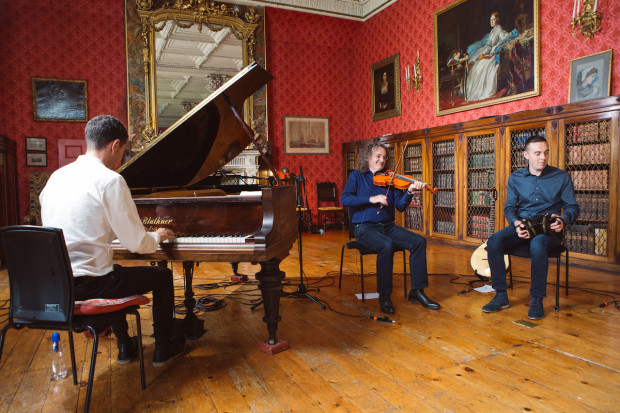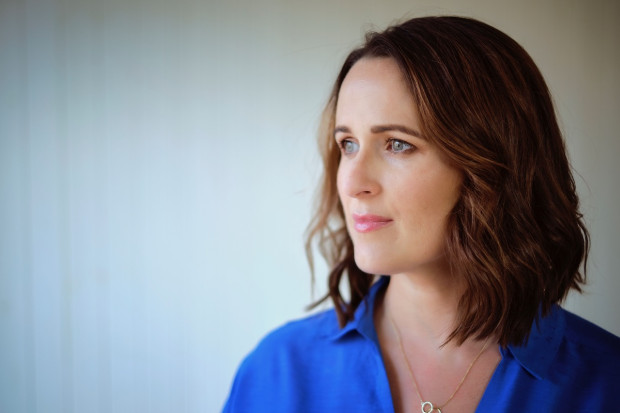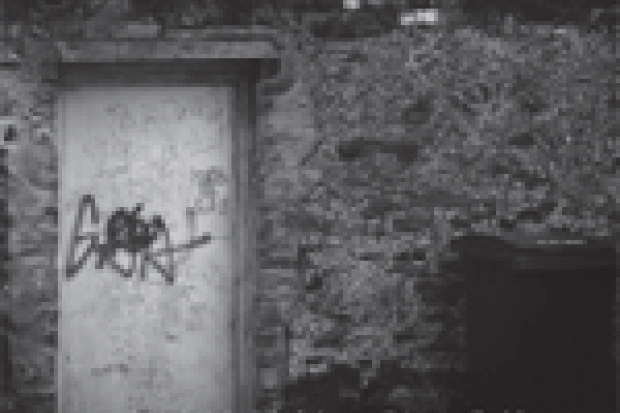Live Reviews: Caoimhín Ó Raghaillaigh, with Jane Hughes and Lorcan Mac Mathuna
St Brendan’s Church, Bantry,
17 March 2006
Outside the confines of the Church of St Brendan the Navigator in Bantry, the populace celebrated the National Feast with the customary mixture of ballads and booze. Inside, Caoimhín Ó Raghaillaigh (Hardanger fiddle, whistles), Jane Hughes (cello) and Lorcán Mac Mathúna (voice) produced a fascinating alternative – distinctively Irish but without an atom of the paddywhackery that has come to infect the St Patrick’s Day celebrations.
In front of the altar of St Brendan’s stood a raised platform with three chairs, three music stands and a standard lamp. The ecclesiastical surroundings – complete with memorials to various Earls of Bantry and an unusual square organ – heightened the sense of anticipation. Lorcán Mac Mathúna was first on stage, still wearing his outdoor jacket. It was cold, very cold for the time of year, and, while the audience had the benefit of underseat heating which struggled to raise the ambient temperature, the performers had no such luxury. But the cold vanished instantly with the opening song, ‘Tuirimh Mhic Fhinnín Dhubh’. Mac Mathúna’s performance of this unusual eighteenth-century song was commanding. A young man with a Dublin accent and musical heart based deep in Múscraí, Mac Mathúna has, on this evidence, both the voice and the attitude to place him in the first rank of the new wave of traditional singers.
Caoimhín Ó Raghaillaigh and Jane Hughes joined him on stage for ‘Caoineadh na dTrí Mhuire’, unaccompanied at first, then supported by flute and, later, cello. The effect was beautiful and spare; the scene was fully set for the rest of the evening. Hardanger fiddle made its first appearance for ‘An Táilliúirín’, providing a suitably playful backing even if the over-enthusiastic interplay of cello and fiddle threatened to drown the voice on occasion.
A native of Norway, the Hardanger fiddle has, in addition to the four ‘playing’ strings, a course of five sympathetic strings that run underneath the fingerboard, adding overtones and resonances to the original sound. Ó Raghaillaigh described the plight of the Hardanger fiddle player: ‘You spend half your time tuning it and the other half playing out of tune!’ The Hardanger stepped to the fore on the reels, ‘Rolling in the Ryegrass’ and ‘The Mother & Child’. The delight of the player communicated itself to the audience. After the first couple of rounds, the melody shifted out of focus but continued in the mind of the listener, while Ó Raghallaigh carried the rhythm and harmony duties, hinting at the mainline, and gliding towards a clever landing. Later, his performance of ‘The Foxchase’ – the full monty of march, reel, slow air and hop jig – proved the remarkable capabilities of both player and instrument.
The second half opened with Callanish IV, a piece for solo cello composed by Scot John Maxwell Geddes in the 1970s. The Celtic mist curled ominously around the description. Geddes wrote the piece after a night spent sleeping next to prehistoric megaliths on the Isle of Lewis. The reality was, fortunately, different. The atmosphere was augmented by the dimming of the church lights and the fact that Hughes had positioned herself at the rear of the church, behind the audience, but the piece created a proud ambience of its own. Hughes made something remarkable of Geddes’ piece, delivering a well-judged mix of technique and expression.
And so it continued – ‘An Rógaire Dubh’, with voice and interwoven fiddle; ‘Aisling Gheal’, with an inventive cello line; ‘Ag Casadh an tSúgáin’, where the cello strayed delightfully into cheap tricks terrain; and ‘Cath Chéim an Fhia’, surely the finest commemoration of an insignificant skirmish in the history of music.
The template created by Ó Raghallaigh, Hughes and Mac Mathúna is sound but hardly complete. The lack of adequate introductions to the songs, particularly in the opening half, detracted from the enjoyment of an audience, few of whom, at an educated guess, understood the language of the songs. Some of the accompaniment was based too obviously on standard music theory; more imagination, more subtlety – and, perhaps, more rehearsal time – would have enhanced the experience. And, despite the patent beauty and character of the Hardanger fiddle, some of us longed for a few tunes on a ‘real’ fiddle. But this was a first outing, after all, and the ideas presented here will develop with time.
A performance such as this requires a responsive audience and a sympathetic venue. In St Brendan’s it had both. But there are audiences and venues such as these throughout the country. All it takes is a little imagination such as that shown by Francis Humphrys and his team at West Cork Music.
Published on 1 May 2006
Pat Ahern is a musician and producer. He lectures in mathematics at Cork Institute of Technology.














